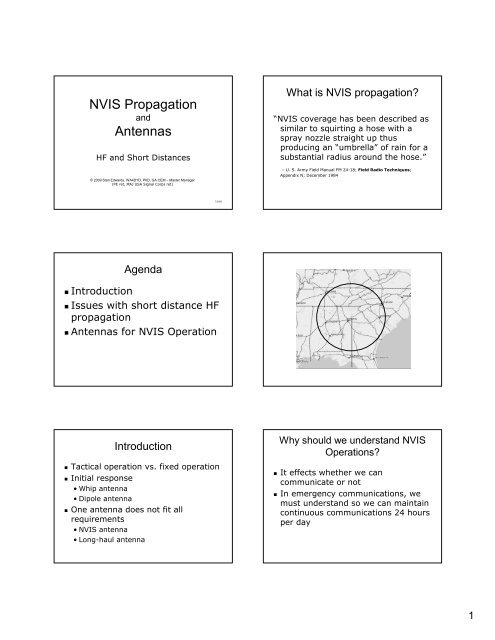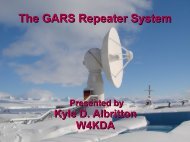NVIS antenna - ARES: Gwinnett County
NVIS antenna - ARES: Gwinnett County
NVIS antenna - ARES: Gwinnett County
Create successful ePaper yourself
Turn your PDF publications into a flip-book with our unique Google optimized e-Paper software.
<strong>NVIS</strong> Propagation<br />
and<br />
Antennas<br />
HF and Short Distances<br />
© 2009 Stan Edwards, WA4DYD, PhD, GA CEM – Master Manager<br />
(PE ret, MAJ USA Signal Corps ret)<br />
� Introduction<br />
Agenda<br />
� Issues with short distance HF<br />
propagation<br />
� Antennas for <strong>NVIS</strong> Operation<br />
Introduction<br />
� Tactical operation vs. fixed operation<br />
� Initial response<br />
• Whip <strong>antenna</strong><br />
• Dipole <strong>antenna</strong><br />
� One <strong>antenna</strong> does not fit all<br />
requirements<br />
• <strong>NVIS</strong> <strong>antenna</strong><br />
• Long-haul <strong>antenna</strong><br />
7/2009<br />
What is <strong>NVIS</strong> propagation?<br />
“<strong>NVIS</strong> coverage has been described as<br />
similar to squirting a hose with a<br />
spray nozzle straight up thus<br />
producing an “umbrella” of rain for a<br />
substantial radius around the hose.”<br />
– U. S. Army Field Manual FM 24-18; Field Radio Techniques;<br />
Appendix N; December 1984<br />
Why should we understand <strong>NVIS</strong><br />
Operations?<br />
� It effects whether we can<br />
communicate or not<br />
� In emergency communications, we<br />
must understand so we can maintain<br />
continuous communications 24 hours<br />
per day<br />
1
F2 Region<br />
F1 Region<br />
E Region<br />
Near Vertical Incidence Sky-wave<br />
Transmitter<br />
Earth<br />
Receiver<br />
Impact of Solar Activity<br />
Distance<br />
0<br />
25<br />
50<br />
100<br />
200<br />
300<br />
SSN 10<br />
2-4 MHz<br />
2-4 MHz<br />
2-4 MHz<br />
2-5 MHz<br />
2-6 MHz<br />
2-6 MHz<br />
“Employing an Antenna Family for Optimum Tactical HF Radio Effectiveness” by A. S. Christinsin, P.E., November 1973<br />
SSN 110<br />
2-5 MHz<br />
2-5 MHz<br />
3-6 MHz<br />
3-9 MHz<br />
4-10 MHz<br />
4-12 MHz<br />
Impact of Summer vs. Non-summer<br />
Distance<br />
0<br />
25<br />
50<br />
100<br />
200<br />
300<br />
Low Angle<br />
(Other Than Summer Day)<br />
90<br />
85<br />
80<br />
70<br />
55<br />
45<br />
“Employing an Antenna Family for Optimum Tactical HF Radio Effectiveness” by A. S. Christinsin, P.E., November 1973<br />
High Angle<br />
(Summer Day)<br />
90<br />
85<br />
85<br />
80<br />
70<br />
60<br />
Issues<br />
� On some paths, particularly unobstructed<br />
short ones, ground wave propagation may<br />
also be possible and interact with skywave<br />
propagation - problem<br />
� As path becomes shorter, MUF becomes<br />
lower<br />
� Lower frequency waves are more<br />
susceptible to absorption<br />
� As frequency lowers, noise levels go up:<br />
5-8 db going from 40M to 80M; 8-9 db<br />
going from 80M to 160M<br />
Antenna Considerations<br />
� Site Selection (skywave <strong>NVIS</strong><br />
operation – normally horizontal<br />
<strong>antenna</strong>s)<br />
• Reasonably level terrain<br />
• Foliage down at ground level under the<br />
<strong>antenna</strong> and at least a half wavelength<br />
around the <strong>antenna</strong><br />
• Shielding angles to the horizon should<br />
not exceed about 45 degrees for 250<br />
miles – higher angles for shorter paths<br />
“Some Considerations Relative to HF Facility Siting in a Tactical Environment” by A. S. Christinsin, P.E., July 1977<br />
Antenna Considerations<br />
� Site Selection - General<br />
• Away from high tension (>440VAC) lines at<br />
least 1,000 ft.<br />
• Away from low voltage (
Optimum Radiation Pattern<br />
“<strong>NVIS</strong> <strong>antenna</strong> fundamentals”, Edward J. Farmer, Army Communicator, Fall 1994, p 19<br />
Antenna Considerations<br />
� Usual <strong>NVIS</strong> height objective is 0.1 to<br />
0.25 wavelength<br />
• 160M: 49-123 ft.<br />
• 80M: 26-60 ft.<br />
• 40M: 14-30 ft.<br />
Possible <strong>NVIS</strong> Antennas<br />
� Dipoles at appropriate heights<br />
� Dipoles at compromise height<br />
� Compromise dipoles at appropriate<br />
heights<br />
� Compromise dipoles at compromise<br />
height(s)<br />
� Poor man’s AS-2259/GR<br />
� Whip pulled over so it radiates<br />
upward<br />
Compromise Dipoles At<br />
Compromise Height<br />
Compromise Dipole At<br />
Compromise Height<br />
AS-2259/GR<br />
The<br />
Buddipole TM<br />
3
AS-2259/GR<br />
Poor Man’s AS-2259/GR<br />
A Poor Man's Portable Emergency <strong>NVIS</strong> Antenna System, W. Stanley<br />
(Stan) Edwards, WA4DYD, Antenna Compendium, Vol. 7, ARRL, pp 9-11<br />
Poor Man’s AS-2259/GR<br />
Bent Whip Antenna<br />
References<br />
� Field Antenna Handbook, Prepared by James A.<br />
Kuch, Department of Defense Electromagnetic<br />
Compatibility Analysis Center, Annapolis, MD,<br />
June 1984<br />
� Various articles by A. S. Christinsin, PE who was<br />
the Chief of the Air Force Communications<br />
Systems (AFCS) Spectrum Management<br />
Division and AFCS Command Frequency<br />
Manager<br />
� Various articles on <strong>NVIS</strong> operation from the<br />
Army Communicator<br />
Websites<br />
� http://groups.yahoo.com/group/<strong>NVIS</strong>/<br />
� http://www.globalsecurity.org/militar<br />
y/library/policy/army/fm/24-19/<br />
4



